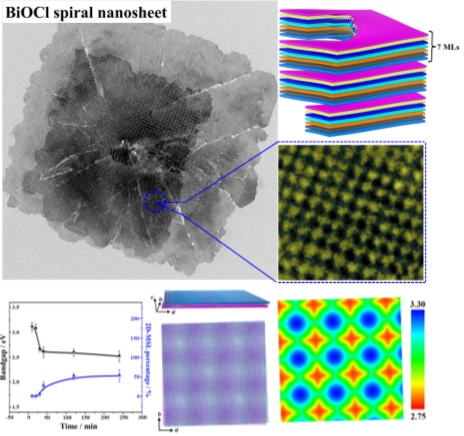The research results of the School Materials Science and Engineering of Jilin University were published in “Nature-Communications”
The scientific research team led by Prof. Xiaoqiang Cui, Prof. Lijun Zhang and Prof. Weitao Zheng of School Materials Science and Engineering has made important progress in the study of the growth and the physical and chemical properties of the two-dimensional Moiré superlattices materials. This work was published in the journal “Nature Communications” on October 2, 2019, entitled “Bottom-up growth of homogeneous Moiré superlattices in bismuth oxychloride spiral nanosheets”(Nature Communications 10, 4472 (2019)), which attracted the attention of peers at domestic and foreign, and wrote special blog reports at the Nature Research Chemistry Community(Fabricating Moiré superlattice by a new way, Oct 03, 2019). The experimental part is performed by the Low-Dimensional Material Group led by Prof. Weitao Zheng and the Surface/Interface Modulation and Properties of Low-Dimensional Material Group led by Prof. Xiaoqiang Cui. The theoretical part is done by the Theory&Design of Optoelectronic Semiconductors Group led by Prof. Lijun Zhang. Dr. Lulu Liu (in experiment) and Dr. Yuanhui Sun (in theory) contributed equally to this work.

Picture taken from Nature Communications 10, 4472 (2019)
The Moiré superlattices (MSLs) is a particularly interesting case of van der Waals two-dimensional (2D) layers, consisting of a modulated structure produced from two homogeneous layers stacked with a twist angle or two heterogeneous layers incorporating a lattice mismatch and/or a twist angle. The main characteristic of the MSLs is the appearance of unique global structure periodicity and symmetry distinct from the constituent single layers, e.g. the recent cases of superconductivity in magic-angle MSLs graphene. Especially for the homogeneous MSLs, to our best knowledge thus far it is only achieved in stacked graphenes. It is therefore strongly desirable to find ways of fabricating new MSLs consisting of alternative 2D material sublayers and exploring their emergent new properties. We unexpectly find a new way of realization of homogeneous MSLs based on a wide-gap 2D semiconductor BiOCl completely from a bottom-up synthetic approach. Unlike the usual approaches fabricating MSLs, our MSLs are prepared through one-pot solvothermal chemical growth of spiral-type nanosheets under a screw-dislocation driven mechanism. We find that such spiral MSLs of BiOCl exhibit fascinating physical properties including unusually large ~0.6 eV band-gap reduction, and two-fold increase in carrier lifetime. These emergent properties render BiOCl an optically active material in visible-light region with enhanced optoelectronic conversion effeciency. More importantly, we find emergent chemical properties, specifically in photocatalysis. Our first-principles electronic structure calculations reproduce the large band-gap reduction and identify the charge separation behavior across the MSLs that is responsible for the increased carrier lifetime. Further analyses indicate that such unusual properties can be ascribed to the locally enhanced inter-layer coupling effect associated with the Moiré potential modulation. Research work has achieved large-scale band-gap regulation of wide band gap layered semiconductor materials. This work demonstrates that two-dimensional MSLs not only have unique physical and chemical properties, but also exhibit significantly improved photocatalytic activity. It indicates that two-dimensional MSLs have potential applications in electronics, optics, and practical environmental purifications.
This work was funded by the key R&D plans of the Ministry of science and technology, the National Natural Science Foundation of China, the Excellent Young Scientists Fund, the high-level scientific and technological innovation team of Jilin University, and the special professors of Changbaishan scholars in Jilin Province. Also this work cannot be done without the valuable collaborative efforts from Prof. Qiaoliang Bao (Monash University), Prof. Jiong Lu (National University of Singapore), Prof. Peng Zhang (Dalhousie University), Prof. Lirong Zheng (Institute of High Energy Physics, CAS), Prof. Liping Yu (University of Maine), Prof. David J. Singh (University of Missouri), and Prof. Qihua Xiong (Nanyang Technological University, Singapore).